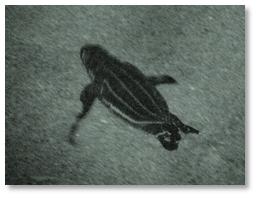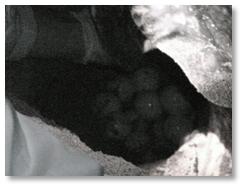We started the day, yesterday, by moving Dignity back round to Prickly Bay so we could shop for drinks and be close to the turtle tour evening pickup. The short motor round from Hog Bay, with the wind and current behind us, was a breeze.
Before it became too warm Helen and I went ashore, walked to the nearby highway and visited a number of shops: ACE Hardware (for a power multiblock), NY Bagels (for a snack), a Cash & Carry and the Grenada Brewery outlet. At the latter we picked up a couple of crates of beer and a crate of Ting which we lugged back to the boat on our trolley.
We rested through midday. In the afternoon I picked up dinghy fuel from Prickly Bay Marina and made another trip back to the brewery outlet for two more crates of Ting and one more crate of beer. We are now set, drinkwise, for June and July.
At 6pm we met up outside Budget Marine with Cutty and a number of other cruisers to be taken to the north of the island to see turtles coming ashore to lay their eggs. For the record, among the group were Liz & Bob from Yanena (probably spelt incorrectly) who arranged the group outing, Judy, Jim & Charlotte from Heatwave and Marianne and Theo from Double Dutch. Hopefully we’ll see these folks again.
The trip north took around 90 minutes. We stopped off about 10-15 minutes before the target beach to pick up our guide who was associated with a local research group. She gave us a short brief on what to expect and some do’s and don’ts – in particular no white torches and no camera flashes as these would disturb the turtles.
 We arrived at the beach around 8pm and began waiting. We saw no action until around 9:30pm when someone spotted some baby turtles hatching and we received word that a turtle had landed at the other end of the beach around 700 meters away.
We arrived at the beach around 8pm and began waiting. We saw no action until around 9:30pm when someone spotted some baby turtles hatching and we received word that a turtle had landed at the other end of the beach around 700 meters away.
We first made our way over to where the baby turtles were surfacing. The average nest has around 100 eggs, most of which will hatch successfully. In this case we saw around six to eight early arrivals scrambling around roughly making their way to the sea.
A few who had red light torches were able to guide the baby turtles to the sea by shining their light ahead of them as they had an instinct to follow the light.
Here is a brief video of the baby turtles crossing the sand
[youtube]http://www.youtube.com/watch?v=JrU1FAqiCNw[/youtube]
Next we trudged to the other end of the beach to see the turtle reported to have landed there. Along the way we were nervous of treading on other baby turtles that may be hatching and making their way to the sea. Fortunately, I don’t think we squished any. Nor did we see any others. In the low light our eyes would play tricks on us. In the distance I thought I saw a massive turtle but it turned out to be a boat.
E ventually we made it all the way to the other end of the beach where we found some researchers helping a 1000lb turtle dig her nest. She was having difficulties as her right flipped appeared injured and was not removing sand effectively. The turtle would only begin laying her eggs when she can feel no more sand beneath her. This was not going to happen without help.
ventually we made it all the way to the other end of the beach where we found some researchers helping a 1000lb turtle dig her nest. She was having difficulties as her right flipped appeared injured and was not removing sand effectively. The turtle would only begin laying her eggs when she can feel no more sand beneath her. This was not going to happen without help.
 It was exhausting just watching her and eventually a reflex must have triggered and she abandoned this attempt to try elsewhere.
It was exhausting just watching her and eventually a reflex must have triggered and she abandoned this attempt to try elsewhere.
The researchers knew when we were able to come close to watch. During the early digging we were asked to stand well away which we did. As the hole developed we were allowed to come close. When this turtle made a second attempt she was left alone with just the researchers to help as this was clearly going to be a difficult night for her.
Fortunately, another turtle came ashore as we were heading back to the taxi. Again we stood off until it was ok to come near. This turtle was fit and able to dig her hole without assistance. Soon we were able to come close and watch. Methodically she would excavate each side of the hole with her hind flippers creating quite a deep, squarish hole for her eggs.
came ashore as we were heading back to the taxi. Again we stood off until it was ok to come near. This turtle was fit and able to dig her hole without assistance. Soon we were able to come close and watch. Methodically she would excavate each side of the hole with her hind flippers creating quite a deep, squarish hole for her eggs.
 When her senses told it was time she went into her egg laying trance. In this mode she was practically senseless to what was going on around. We were able to touch her carapace (soft shell) and her fore flippers without disturbing her. She was also unphazed by the researcher holding her rear flippers apart so they could count the eggs and we could see them.
When her senses told it was time she went into her egg laying trance. In this mode she was practically senseless to what was going on around. We were able to touch her carapace (soft shell) and her fore flippers without disturbing her. She was also unphazed by the researcher holding her rear flippers apart so they could count the eggs and we could see them.
In order to preserve the species they were prepared to move the nest if it was too damp which would put the eggs at risk. The researchers felt this nest was ok so no preparations were made. Two types of eggs are laid. Normal yolk filled eggs are laid which will produced babies. Around these, smaller yolkless eggs are laid as filler so that the yolked eggs don’t get too much sand between them.
Midnight approached so we had to head back to the taxi careful again to avoid any possible hatchlings. We saw a third turtle ashore to nest and lay her eggs along the way. It was nearly 2pm before we finally returned to Dignity. We were exhausted and fell asleep immediately. This was a one of a kind day and if you ever get an opportunity to do this yourself, seize it.
Here is a video of the two turtles we saw digging their nests. You should see the difference between the injured turtle in the first half and the fit turtle in the latter. Enjoy.
[youtube]http://www.youtube.com/watch?v=iquyH7qJJ6I[/youtube]
Finally – all the pics.
Leave a Reply